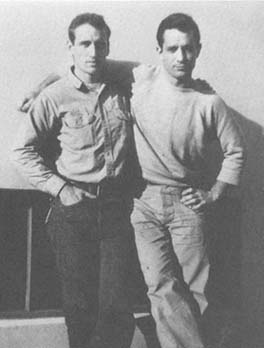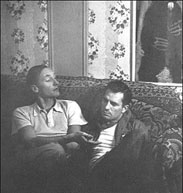|
Jack Kerouac1922-1969
Jack had met Cassady through mutual friends at Columbia University. Jack had come to Columbia on a football scholarship, but had dropped out at the start of his second year. It had been a generally rough period in his life. His parents' finances had just gone to hell and his father was retreating into alcoholism. Meanwhile Jack was flunking out, had been seriously injured in a game, and had huge fight with his coach. It was classic Jack to play the injured, angry bear and tell everyone to go to hell. Off he went to join the Navy. But he soon found himself ill-suited to the service, and feigned insanity to get discharged. In 1944 he was back in New York, sponging off girlfriend Edie Parker and meeting Columbia students Lucien Carr, Allen Ginsberg and a smooth, worldly-wise Harvard Grad named William S. Burroughs.
Though it took a while for Jack to warm up to Neal, he eventually became utterly besotted with Neal and his zestful enthusiasm for life. Whereas Jack tended, on his own, to spiral into a gravitational well of resentful drunkenness and deep dependence on his mother, Neal seemed veritably bursting with manly exuberance. According to Kerouac Neal Cassady could: run one hundred yards in ten seconds, pass a football seventy yards, do fifty chin-ups in a row, broad jump twenty-three feet, and masturbate six times a day. It was inevitable then that Jack would "shamble" along after Neal in a series of wild road adventures. But when On the Road was finally published in '57, no one seemed to get that Jack was not the alter ego of the wild, exuberant main character Dean Moriarity. People kept asking him to explain what the Beat movement was all about. But Jack wasn't interested in the "Beatnik" craze. He was just drawn to his adventure with Neal like a moth to a flame. And duly recorded what had so amazed him. Jack wanted to talk about literary style, the wild new rhythm of his words, the amazing accomplishment of having written On the Road, high on Benzedrine, in a marathon "kick-writing" session that lasted about three weeks and produced a continuous 120 foot long single-spaced paragraph, utilizing 12 foot long sheets of art paper taped end to end. Nobody seemed to care. It was Dean Moriarity they wanted. And Dean Moriarity was actually Neal Cassady. Kerouac was to have a few more wild adventures over the next decade with Cassady (like sharing Neal's wife Carolyn) as well as with Ginsberg and Bill Burroughs (he visited Burroughs in Tangiers and hung out with Ginsberg in Paris). And he wrote and published more works after On the Road. But increasingly Jack was becoming a drunkard, and a bitter one at that. He moved back in to live with his French Canadian mother in New York and then Florida. Jack's mother took to screening her son's phone calls and opening his letters. She wrote particularly scathing letters to Allen Ginsberg, whom she hated for being a homosexual and a Jew, and told him that he and Jack's other freaky, immoral friends better keep away. Jack was silent. Over the years his old friends tried to roust the drunken bear out of his den (Ginsberg used to hide in the bushes and send lover Peter Orlovsky to knock on the door), but to little avail. Jack could not be budged from his mother and his deepening conservatism. It was as William S. Burroughs had predicted in their early days in New York, if Jack failed to break free of his mother's apron strings he would eventually become completely trapped until finally he just wound down and died. And so he did, on October 20, 1969. Outwardly he appeared to have died from alcoholism. But inwardly, some dark landscape, comforting and familiar, had consumed and annihilated him, leaving only his words and the loving memories of his friends from better days, on the road.
timeline
|
 Jack Kerouac is typically remembered as the author of On the Road, the quintessential Beat Generation novel. Like most of Kerouac's work, it was autobiographical, drawn from his own life experience and given rhythm and color by the personalities and adventures he'd experienced along the way. Unlike in his first novel, The Town and the City, (in which Kerouac had invented elaborate characters and plots, only loosely inspired by real life events), when he finally sat down to create the published version of On The Road, Kerouac decided to thoroughly immerse the reader in the real events and characters he'd experienced exploring the highways and alleys of America with pal
Jack Kerouac is typically remembered as the author of On the Road, the quintessential Beat Generation novel. Like most of Kerouac's work, it was autobiographical, drawn from his own life experience and given rhythm and color by the personalities and adventures he'd experienced along the way. Unlike in his first novel, The Town and the City, (in which Kerouac had invented elaborate characters and plots, only loosely inspired by real life events), when he finally sat down to create the published version of On The Road, Kerouac decided to thoroughly immerse the reader in the real events and characters he'd experienced exploring the highways and alleys of America with pal  The three in turn hooked Jack up with a variety of other characters including petty criminal and junkie Herbert Huncke. Jack thence became embroiled in one wild subplot after another: having spurious sexual encounters with Ginsberg, a homosexual orgy with Burroughs and his friends, being taken by the two to a Turkish Bath where he was blown by several French sailors (Jack maintained he was hetero however), plus introducing the group to Benzedrine (which would fuel many of their writing sessions and ruin their mental and physical health), and getting thrown into jail for failing to report Lucien Carr's killing of gay admirer David Kammerer. Meanwhile, Jack's mother was supporting him, his father despising him, and his first novel, though published, was a financial flop. Enter
The three in turn hooked Jack up with a variety of other characters including petty criminal and junkie Herbert Huncke. Jack thence became embroiled in one wild subplot after another: having spurious sexual encounters with Ginsberg, a homosexual orgy with Burroughs and his friends, being taken by the two to a Turkish Bath where he was blown by several French sailors (Jack maintained he was hetero however), plus introducing the group to Benzedrine (which would fuel many of their writing sessions and ruin their mental and physical health), and getting thrown into jail for failing to report Lucien Carr's killing of gay admirer David Kammerer. Meanwhile, Jack's mother was supporting him, his father despising him, and his first novel, though published, was a financial flop. Enter